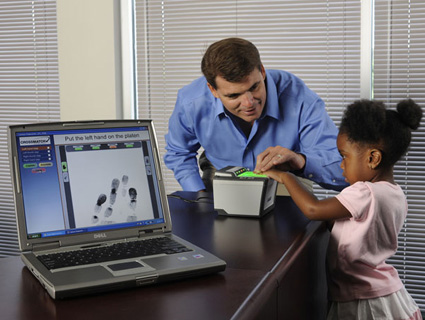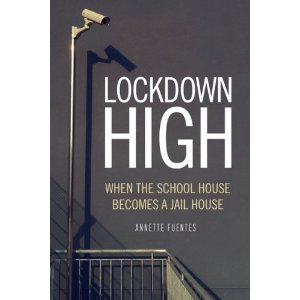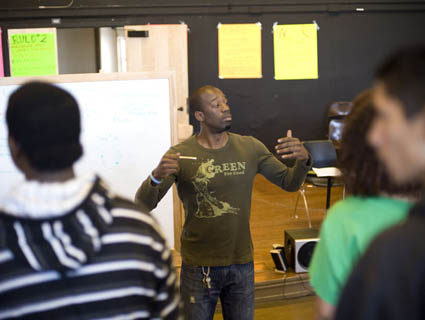
Photo: <a href="http://www.crossmatch.com/child-id-solutions.php">Crossmatch Technologies</a>
[Editors’ Note: The excerpt below is adapted from the book Lockdown High, which is out this month from Verso.]
For millions of children, being scanned and monitored has become as much a part of their daily education as learning to read and write. But while metal detectors and video surveillance have been used for years in public schools, new military and corrections technologies are quietly moving into the classroom with little oversight. Biometric systems with prison applications, such as iris recognition and fingerprint scans, are already being deployed in some high schools to monitor Internet usage. Computer programs that check school visitor identities against sex offender lists are gaining popularity. And radio frequency identification (RFID), developed for military applications and now commonly used by industry, is being promoted for tracking students. The mantra of school safety is being used to justify technology for its own sake—and for the profits of savvy entrepreneurs.
“There is a conflation of interests right now,” says Nicole Ozer, technology and civil liberties specialist at the Northern California ACLU. “Companies want to make money and government wants to create a surveillance infrastructure. Homeland Security is sending down millions to communities that want to look like they are doing something about crime. After Columbine, people don’t even question it in schools. They say one of three things to justify the surveillance: terrorism, crime, or child safety. They employ things that don’t really address problems in schools. Why not more counselors?”
In 1998, Congress reacted to a spate of high-profile shootings over the previous year by enacting the Safe Schools Initiative (PDF), a seemingly muscular program meant to show how seriously lawmakers took school violence. Among other things, the initiative directed the National Institute of Justice to develop new and appropriate weapons detection and surveillance technologies for schools. NIJ created a School Safety Program and made its National Law Enforcement and Corrections Technology Centers—Southeast the home for research into state-of-the-art policing and prison technologies that could apply to public schools. At the same time, NIJ funded Sandia National Laboratories, a Department of Energy facility in Albuquerque, New Mexico, to apply its expertise in security technologies to schools. Sandia is run by the defense and aeronautics behemoth Lockheed Martin under contract to the Department of Energy and primarily supports the US nuclear weapons program. Facilitating Sandia’s work on public schools was Senator Jeff Bingham of New Mexico, who earmarked funds to one of his home state’s big employers.
 Click here to buy the book.Sandia’s Security Technologies and Research Division had been working on school security since about 1991, according to Mary W. Green, who was among those employees involved. The division had several hundred staffers researching security for high-risk facilities, such as nuclear power plants. Green recalls that people in her unit were contacted by local school officials who asked about security technology for their buildings. “All of us were into schools. We had kids. We were these nerdy types who wore polyester. My husband’s pants were about four inches too short,” she says with a laugh. “We were invited to school meetings and went on our own time and used discretionary funds.” Green and her bosses wanted to share what they knew, a technology transfer to schools at a time when school security had become a “hot issue,” she says. Sandia undertook a pilot project at Belen High School, south of Alberquerque, funded by the Department of Energy. Later, the NIJ money funded Sandia to research and test security hardware, such as metal detectors and surveillance cameras, to determine what works and what doesn’t in a school. “One of the big impetuses for us to get into this is that the security industry isn’t regulated. Anybody can open up shop and call themselves security experts,” Green notes. “Schools notoriously have to go with the lowest bidder, and they get the junk.” She recalls visiting a Washington, D.C., school that had wired part of the building for new alarms. “They didn’t bother running the wiring through the walls,” she says. “They just ran it along a hallway. It broke my heart. A school can get a couple thousand and just waste it.”
Click here to buy the book.Sandia’s Security Technologies and Research Division had been working on school security since about 1991, according to Mary W. Green, who was among those employees involved. The division had several hundred staffers researching security for high-risk facilities, such as nuclear power plants. Green recalls that people in her unit were contacted by local school officials who asked about security technology for their buildings. “All of us were into schools. We had kids. We were these nerdy types who wore polyester. My husband’s pants were about four inches too short,” she says with a laugh. “We were invited to school meetings and went on our own time and used discretionary funds.” Green and her bosses wanted to share what they knew, a technology transfer to schools at a time when school security had become a “hot issue,” she says. Sandia undertook a pilot project at Belen High School, south of Alberquerque, funded by the Department of Energy. Later, the NIJ money funded Sandia to research and test security hardware, such as metal detectors and surveillance cameras, to determine what works and what doesn’t in a school. “One of the big impetuses for us to get into this is that the security industry isn’t regulated. Anybody can open up shop and call themselves security experts,” Green notes. “Schools notoriously have to go with the lowest bidder, and they get the junk.” She recalls visiting a Washington, D.C., school that had wired part of the building for new alarms. “They didn’t bother running the wiring through the walls,” she says. “They just ran it along a hallway. It broke my heart. A school can get a couple thousand and just waste it.”
In 1999, NIJ published “The Appropriate and Effective Use of Security Technologies in U.S. Schools,” (PDF) a manual on which Green had spent a year working for schools and law enforcement. Its 129 colorfully illustrated pages detail the pros and cons of video surveillance, metal detectors, and entry control technologies. Chapter One explains the rationales for security hardware when “simply providing more adults” in a school isn’t enough, including “humans don’t do mundane tasks well” and “manpower costs are always increasing.” Back then, security technologies had yet to become as widely accepted as they are today, a fact Green attributed to limited school budgets and experience with technology, as well as privacy and civil rights issues. So she offered counterarguments to those who opposed cameras or metal detection in schools. To the argument “This is a knee-jerk reaction,” the manual recommended parrying, “This solution will take care of the immediate threat while longer term social programs are put in place.” “Our school will look like a prison” should be rebutted with “Our school will look like it is well controlled.” Green’s manual also provides legal advice on the placement and use of video surveillance: avoid areas like gym lockers or bathrooms where there is a “reasonable expectation of privacy.”
Metal detection gets a thorough examination that notes its weaknesses: “a metal detector alone cannot distinguish between a gun and a large metal belt buckle,” “a metal detector is only as good as the operator overseeing its use,” and the clear-eyed observation “It is very difficult to do truly random checks with any hope of locating weapons.” Green’s guide, though nearly a decade old, is still a widely cited resource for school security, and she believes it has had an impact. “Back when I first got involved, people would say, ‘Cameras? Kids will think we don’t trust them. Now cameras are really common, and for that we owe a lot to McDonald’s and Kinko’s. Because of them it’s less unheard-of in schools.” Sadly for Green, the congressional fervor that pumped funding into Sandia’s research cooled when school safety was no longer the “hot” issue, as Green put it. Now Sandia doesn’t work on school security. “I thought it would be my life because schools need this. I’m doing mints now,” Green says wistfully, referring to US currency production facilities, “but it doesn’t have the heart-wrenching thing.”
Down in South Carolina, staff at NIJ‘s National Law Enforcement and Corrections Technology Center—Southeast have also been cooking up new applications of hot security and surveillance technologies for public schools. One of a half-dozen regional centers established by the NIJ, the Southeast Center was assigned the school safety portfolio as its specialty. About a fifth of its budget is dedicated to testing and promoting new technologies for school security, according to Peter Cosgrove, the deputy director. “Our mission is technology-oriented toward law enforcement and corrections,” says Cosgrove. Center staff attend conferences on the latest tech trends and organize annual School Safety Technology Workshops for school administrators to learn from experts. As an example, Cosgrove mentioned a conference in Pittsburgh that he attended in summer 2007 on geospacing, a technology for computer mapping of internal building spaces that was designed for prisons. “Schools and corrections facilities share something in common, in terms of crime mapping,” Cosgrove says. “We’re working on developing a three-dimensional building plan. That same type of technology will be useful in both prisons and schools.” Locating inmates—or students—within the complex warren of cells or classrooms over multiple floors and building wings allows for tracking and identifying the populations, he explains.
Center staff go to technology shows, where they talk to vendors and compare various products. “We’re not allowed to recommend anybody, but we can say, ‘This is on the market and it has these advantages,'” Cosgrove says. One product the center tested is a an interactive software program called Incident Commander, which guides the user through a school-shooting event. “As you go through, it suggests processes,” Cosgrove explains: “how to lock the school down, the colored papers teachers put on their doors to indicate if the room is secure or not, the role of the SRO and the administration. That’s been pretty well received.” At another technology conference, Cosgrove watched demonstrations of surveillance cameras that transmit to local police agencies from schools to aid them in case of an incident. “It’s a fun place. It’s like the MacGyver show, you know, how he could put something together with a piece of string,” he says, referring to a TV detective series. “We kind of think, What’s out there? What has the military got and how can we use this? We’re trying to find new applications.” Another technology with potential for school and prison applications, Cosgrove notes, is RFID—radio frequency identification, commonly used today for toll collection. But it has its drawbacks. “Here’s where people start having privacy issues,” he says. “I might put a chip in my dog but I’m not putting one on my kid. In theory, you could give each kid an ID card imbedded with a small radio chip of a certain frequency, and you could monitor his movements. Again, there’s an analogy with prisons: you could track a prisoner within the prison. With GPS [global positioning systems], you could use it to track people. That technology already exists, but how much do you want the government to know?”
One current focus of the center’s work is cell phones, an effort Cosgrove says is called Detect and Defeat: detect the cell phone and disable it without disabling communication in an entire area. Cosgrove says the technology can apply in prisons, where cell phone use is prohibited, and schools, where it is often restricted. The two institutions, he notes, have much in common. “If you want to stretch the comparison, you have kids in school being educated in life, and in prison you have a similar situation of people being reeducated. In theory they’re not far apart,” Cosgrove philosophizes. “On the administrative side, you’re trying to regulate and control a large group of people, so there are a lot of similarities. So if we’re developing a technology, we can use it in both areas.” Like Green, Cosgrove thinks metal detectors aren’t very effective and create the perception, not the reality, of safer schools. “Metal detection is basically a magnet. It doesn’t tell you much,” Cosgrove says. “Kids carrying backpacks with metal catches or even a jacket with metal buttons will set them off, and if you have to back them down to allow for that, they might not detect a Glock with only a little metal in it. Sometimes in the security business you put things up to make people feel safer as opposed to being safer.”
Of course, not all schools covet the newest biometric or software system for access control. But in some localities, costly high-tech security is as integral to the educational agenda as new textbooks. In one indicator of how important security technology has become in schools, the trade magazine Security published its first ranking of the “biggest and the best security programs in the US” and gave public schools a prominent place on it. Called the Security 500, the list includes fourteen public school districts—six of them in Florida. Ranked 291, Houston Independent School District was tops among schools—and one step above Intel. Number one on the list was the Department of Homeland Security.








